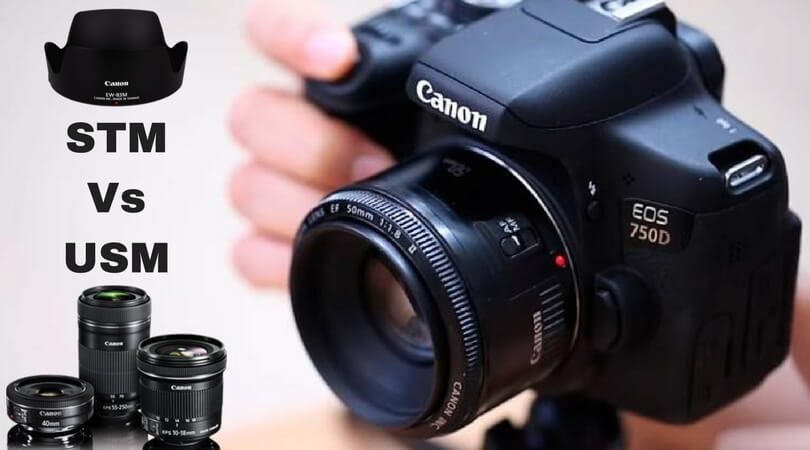Photography is all about focus. Be it the eye for detail or the proper focus while shooting anything, one can’t deny that the focus is an integral part of getting perfect shots. And thankfully, some companies provide us with innovative solutions to capture the perfect shots with the proper focus. One such brand that has excelled in making the lives of people like us easy is Canon.
Very few of you may know that Canon was the first company that integrated a focusing motor inside the lens. Even today, Canon is a step forward in retaining control for focus accuracy, smooth operations, and noise control. Currently, three main types of focusing motor technologies exist: STM, USM, and DC motor. All of these technologies are used by Canon, and in this article, we will talk about Canon STM and USM to help you find the differences between these technologies.
Contents
Canon STM Vs USM
STM and USM are the two types of autofocus systems that are used in Canon lenses. If you plan on buying a Canon lens for your camera body, you may find yourself wondering which of these two lens variants may best suit your needs. So, let’s have a look at the key differences between STM vs the USM lens.
First things first, STM is the acronym used for Stepper Motor, while USM stands for Ultrasonic Motor.
Canon USM
This system is widely used and is found in the best quality Canon lenses. The USM motors convert ultrasonic vibration energy into a rotational force for moving the lens. Between both USM and STM lenses, USM is said to be the faster focusing method out of the two. Currently, Canon offers three types of USM motors which are ring, micro, and nano.
Ring Motors:
These have enough power to drive the focusing lens group quickly and easily at low speed, without the need for a gear system.
They have high holding power, so the focusing lens group is held in place without any input needed once the motor is switched off. They ensure the best focus response by giving a quick start as well as a quick stop.
Micro USM Motor:
It is created in a much smaller and compact way and fits into a wide range of lenses. They are cheaper to produce and are considered more suitable to the consumer range of lenses where cost is an issue. The Micro USM uses a similar sonic vibration motor, but instead of directly coupling with the AF group, a series of gears is used, which results in a more traditional AF drive approach. The motor is silent, but it is the gears that create most of the noise.
Nano USM motor:
Canon introduced this motor in 2016, which achieves a high-speed AF and operates quietly and seamlessly. It is described as the ideal motor for normal-use lenses, which can handle both still photography and movie shooting.
This type of motor features makes it ideally suited for capturing fast action and movies where quiet and smooth focus are the ideal characteristics for focus. In addition, it gives excellent control, which allows for smoother tracking while focusing on your subject as it moves away or towards the camera.
Canon STM
STM lenses, also called a Stepping Motor, allow a smooth and quiet focus to be done with the lens, which is essential when capturing videos. STM lenses focus quietly, therefore allowing you to record what you naturally hear in an environment. In addition, Canon provides a range of extremely quiet lenses which are fast enough to capture photos.
Stepping motors are better at producing smooth, precise incremental movements.
The con to this technology is that the lenses are focus-by-wire. It means that the focus ring isn’t attached to a mechanical mechanism. Instead, the movement of the focus ring merely sends a signal to the motors electronically to change the focus position. As a result, it results in a loss of a lot of the tactile nature of regular focus systems.
There are two types of STM motors:
Gear Type STM:
The gear-type STM is a very compact STM motor that uses helical gears to drive the focus.
Lead-screw Type STM:
These are a more extensive range of STM lenses – which offer greater levels of silence and speed.
Now that we know about these lenses, let’s quickly go through their differences to help you make a better choice.
USM vs. STM
USM | STM |
| Professional-grade technology. | Suitable for beginners and amateurs. |
| Noisy operation as compared to Canon STM. | Silent operation. |
| It is recommended for still photography. | It works better for shooting videos. |
| High-quality build and expensive. | Relatively low in quality and less costly. |
| It offers super-fast autofocus speed, and the lenses are equipped with weather sealing. | It has fast autofocus speed but doesn’t feature weather sealing for lenses. |
Concluding Remarks
When it comes to choosing between USM and STM, it largely depends upon your preferences. If you are professional and have a budget, we would recommend you to opt for USM lenses. However, if you have just started and want to experiment with shooting videos with less noise interruption, our pick will be STM lenses. So based on all the differences we have mentioned, we hope this blog post helps you decide which one is more suitable.

